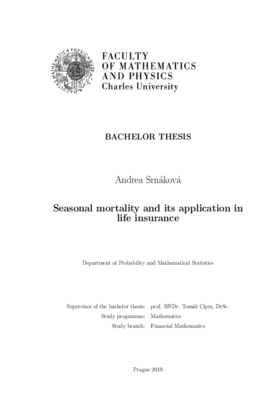Seasonal mortality and its application in life insurance
Úmrtnostní sezónnost a její aplikace v životním pojištění
bakalářská práce (OBHÁJENO)

Zobrazit/
Trvalý odkaz
http://hdl.handle.net/20.500.11956/107844Identifikátory
SIS: 204874
Kolekce
- Kvalifikační práce [10690]
Autor
Vedoucí práce
Oponent práce
Zichová, Jitka
Fakulta / součást
Matematicko-fyzikální fakulta
Obor
Finanční matematika
Katedra / ústav / klinika
Katedra pravděpodobnosti a matematické statistiky
Datum obhajoby
20. 6. 2019
Nakladatel
Univerzita Karlova, Matematicko-fyzikální fakultaJazyk
Angličtina
Známka
Výborně
Klíčová slova (česky)
životní pojištění, trigonometrické řady, cirkulární rozdělení, fraktální věky, úmrtnostní sezónnostKlíčová slova (anglicky)
life insurance, trigonometric sums, circular distribution, fractional ages, seasonal mortalityPredpoklady ako sú rovnomerné rozdelenie, konštantná intenzita úmrtnosti a Balducciho predpoklad, ktoré sa často používajú na modelovanie údajov o úmrtnosti, neodzrkadlujú variabilitu mesačných mier úmrtnosti. Často sa vysky- tuje fenomén nadmernej úmrtnosti v zime, na ktorý tieto predpoklady neberú ohľad. Použijeme predpoklad sezónnej úmrtnosti, ktorý využíva nezáporné trigono- metrické rady na modelovanie rozdelenia mesačných mier úmrtnosti. Naše zis- tenia potom aplikujeme na české údaje o úmrtnosti. Vypočítame mesačné poistné pre prípad krátkodobého životného poistenia a porovnávame výsledok s výsledkami vypočítanými pri použití klasických predpokladov. 1
Assumptions like uniform distribution, constant force of mortality and the Balducci assumption frequently used for modeling mortality data do not reflect the variability of monthly death rates. Often a phenomenon of winter excess mortality occurs, which is not respected by these assumptions. We shall apply a seasonal mortality assumption, which uses non-negative trigonometric sums for modeling the distribution of monthly death rates. We then apply our findings to the Czech mortality data. We calculate monthly premiums in a short-term life insurance policy and compare the result with results given by the classical assumptions. 1
